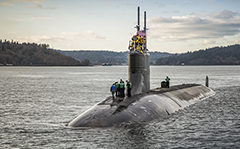During the Cold War, the U.S. Navy developed two different types of nuclear-powered submarines. The first was a sub that could launch nuclear missiles at other nations, called a Fleet Ballistic Missile Submarine, also known as an SSBN or "boomer".
 The other was an Attack Submarine, signified as SSN, or "fast attack." SSBNs are the larger of the two, up to around 560 feet (170 m) in length, while SSNs are built with speed and stealth in mind, and are around 360 feet (109 m) in length.
The other was an Attack Submarine, signified as SSN, or "fast attack." SSBNs are the larger of the two, up to around 560 feet (170 m) in length, while SSNs are built with speed and stealth in mind, and are around 360 feet (109 m) in length.
Nuclear submarines served three primary roles during the Cold War: They performed strategic deterrence patrols, hunted other submarines and carried out special operations.
At least six nations now operate nuclear submarines: the U.S., Russia, India, France, China and the U.K. Several other nations, such as Brazil and Pakistan, are interested or actively attempting to develop (or purchase) nuclear-submarine capabilities. Nuclear submarines offer these nations a bit of prestige, not to mention enhanced offensive and defensive capabilities. As more nations seek to acquire this technology, navies must decide how to reconfigure their fleets. More details
 The other was an Attack Submarine, signified as SSN, or "fast attack." SSBNs are the larger of the two, up to around 560 feet (170 m) in length, while SSNs are built with speed and stealth in mind, and are around 360 feet (109 m) in length.
The other was an Attack Submarine, signified as SSN, or "fast attack." SSBNs are the larger of the two, up to around 560 feet (170 m) in length, while SSNs are built with speed and stealth in mind, and are around 360 feet (109 m) in length.Nuclear submarines served three primary roles during the Cold War: They performed strategic deterrence patrols, hunted other submarines and carried out special operations.
At least six nations now operate nuclear submarines: the U.S., Russia, India, France, China and the U.K. Several other nations, such as Brazil and Pakistan, are interested or actively attempting to develop (or purchase) nuclear-submarine capabilities. Nuclear submarines offer these nations a bit of prestige, not to mention enhanced offensive and defensive capabilities. As more nations seek to acquire this technology, navies must decide how to reconfigure their fleets. More details